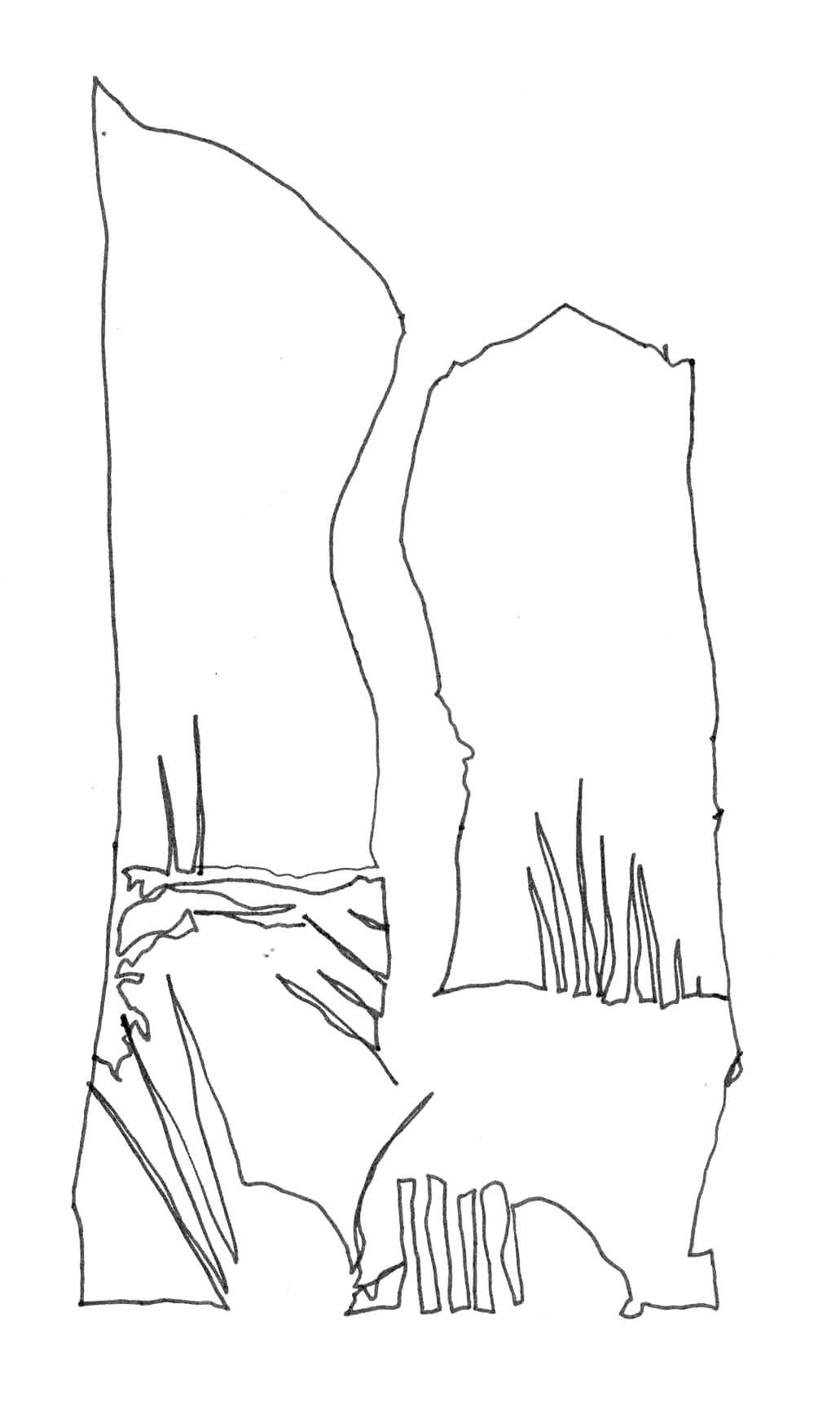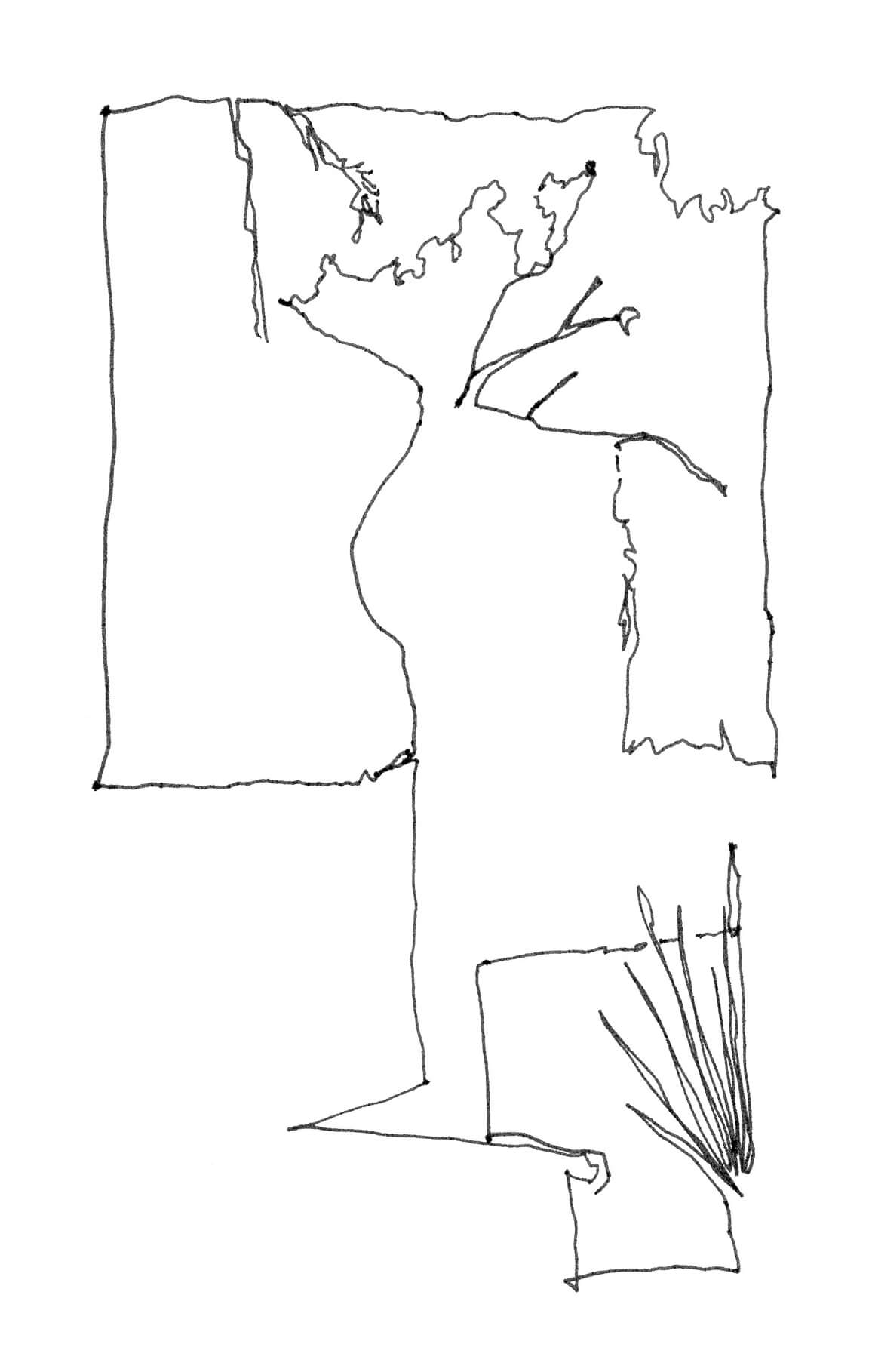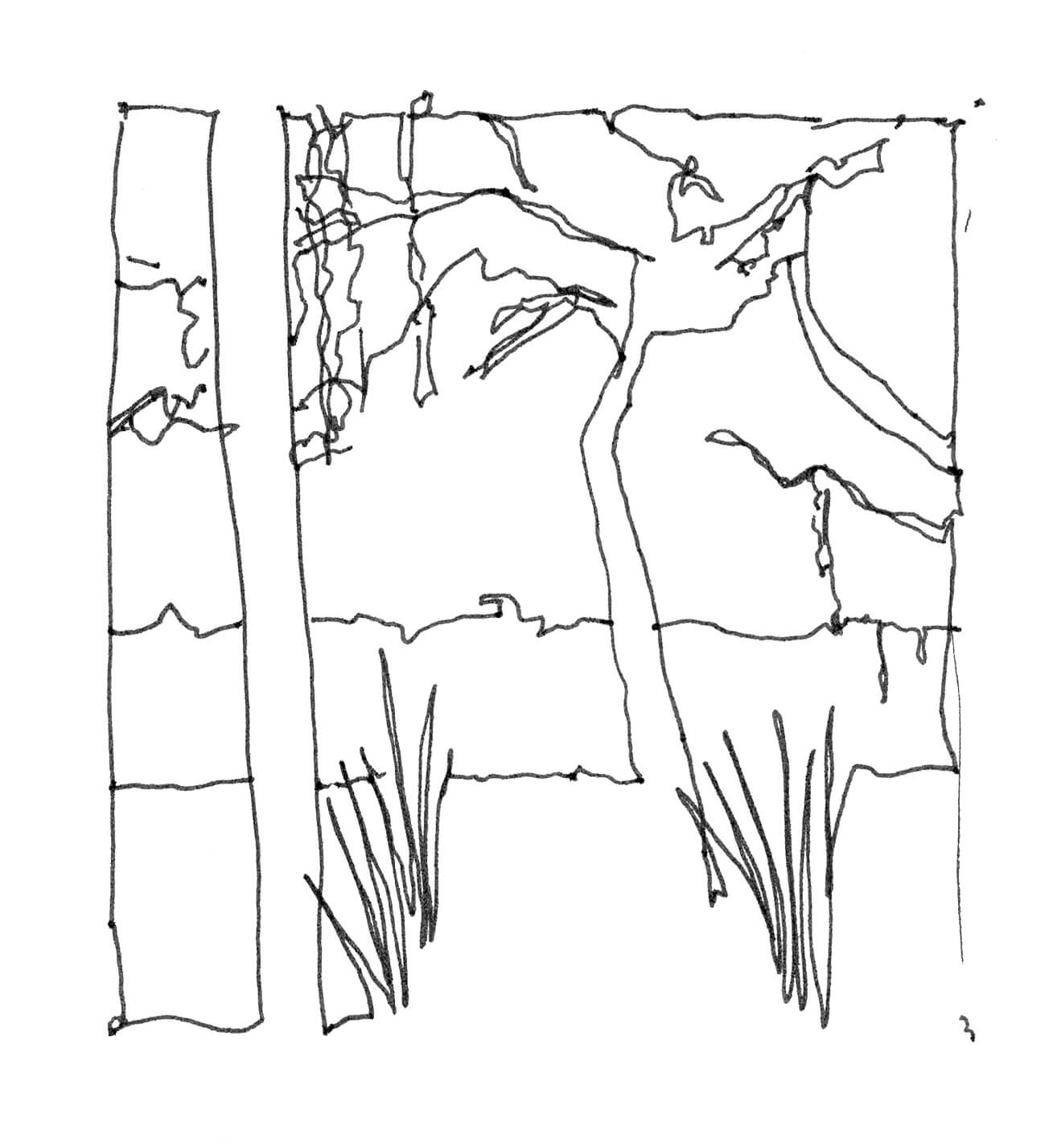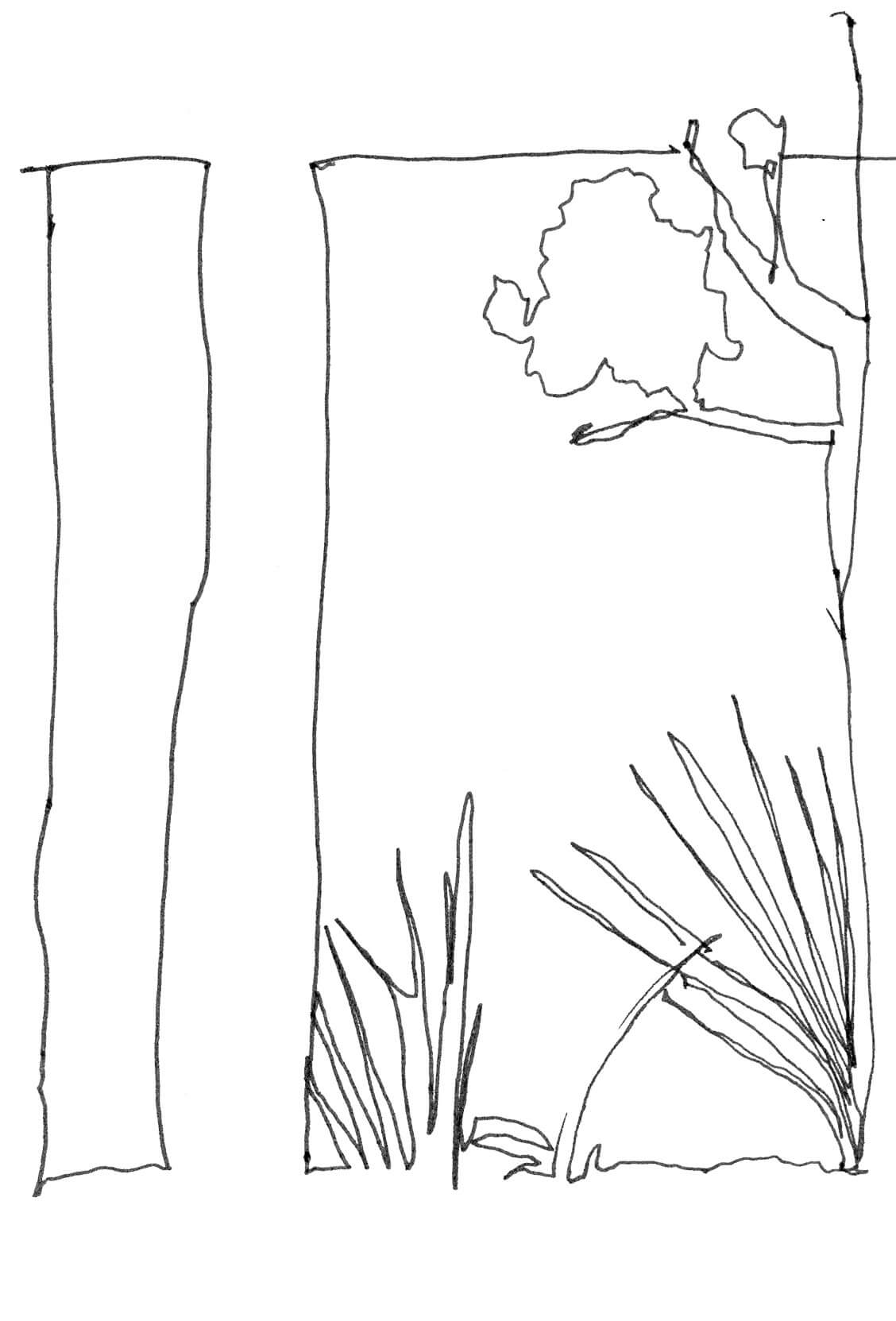The following excerpt is from the first chapter of University of Florida professor Charlie Hailey’s new book, The Porch: Meditations on the Edge of Nature (University of Chicago Press). From the telltale exterior of a humble cabin by the Homosassa River, the architect/writer addresses the effects of climate change and sea level rise as experienced from this place, while ruminating on precedents as varied as a screened sleeping pavilion on the roof of the White House, the stoa of ancient Greece, and the work of Sigurd Lewerentz and Louis Kahn. Ultimately, his musings accumulate into a sort of manifesto offering up the porch as a typology capable of reacclimating humankind to a natural world that it has thrown off-balance.
A manatee’s breath drifts across the porch screen. It is a sound so delicate yet insistent that I stop breathing. I count time in the rings of smoothed water that drift with the river’s current toward the ocean. I listen for the next breath but this manatee is moving fast, and its footprints blend back into the burnished roll and flicker of the river that holds its own breath between tides. The manatees are on the move this January day as Florida warms after a cold snap. What we call fire weather is what most other parts of the country think of as winter, but manatees know the subtle changes of the lower subtropics. They feel the air through water, like we feel it in porches.

That was the fourth manatee I’ve heard in the past hour. The extraordinary can become routine, but it never gets old. Set back from the river, we don’t always see them, except when we catch a black snout sending out its wake like a skidding duck or a piece of driftwood plowing the current, and except that time when a mother came into our lagoon with her calves—the littlest looked like a puppy. There’s another one, louder, closer, but on a porch earshot isn’t necessarily eyeshot. It rained last night, and the cedars drip like metronomes. A kingfisher calls, far enough away to mix with the gentle lapping of breeze and river on limestone. It is quiet today, but it feels like anything can happen. I hear my own breath again, waiting.
•••

This porch where I write will soon be underwater. For seven decades it rode hurricanes and winter storms. In another seven, the sea will cover the boards where three layers of flaking paint sandpaper my bare feet. We do not complain about this reality, neither the porch’s vulnerability nor the paint’s inconstancy. In a position both privileged and ill-advised, I sit here by choice, aware of what’s coming and what’s at stake, saturated by a knowledge of this place and its
climate—one that is constantly and dramatically changing. Here, on the porch, theory meets practice. There’s the idea of a changing climate, and then there’s actually witnessing its effects. Here on a porch, the unseen is inescapable, like the manatee. And the mullet who just splashed in the brackish water taut with low tide. I didn’t see the fish, but I heard the dazed flump of reentry into a river saltier than it was last year, and now watch the ripples widen from this joyful leap.
In our time here, the porch’s floor has been inundated once, and nearly a second time. A fragile wrack line still clings to the porch’s concrete pile, just below the wood framing of its floor. The flecks of cedar needles, tiny bits of shell and soil, left there from this fall’s hurricane, seem trivial compared to what happened up north in Mexico Beach, but it’s all part of the same thing, this living on the coast, which is really living in the coast, deeply embedded in the littoral. Not fixed in place, but held adrift between tides, floating. Like all the things that Hurricane Hermine and her 7-foot storm surge set afloat in our porch and its cabin, four years ago.
When we took the boat out to the cabin the next day, the tannin-stained water was still lapping onto the porch. When my son and I stepped up onto the porch, we walked into a washing machine that had just finished its cycle, one set for heavy soil and turgid water moving this way and that. Even though no doors were ajar or windows broken, it was like someone had ransacked the place, leaving it turned in on itself. Like nature was trying to find us, trying to send a message.
When I walk out on the porch now, I instinctively check the water for signs of change. I watch and hold my breath. I am teaching myself to sit on a porch. I am learning to read what’s around me. Checking for signs, I scan the water. Floating.
•••
(Charlie Hailey)The porch and its cabin were built in 1950, one of the first on the Homosassa River. Here, amid the river’s latticed marriage with the gulf, the fishing is good, so good that Winslow Homer, Grover Cleveland, Thomas Edison, and John Jacob Astor all came looking for redfish, trout, and tarpon.
Land and water are relative terms here. Where one starts and the other stops changes every day, every hour, every minute. If pressed, we could say the cabin is halfway between land and water, halfway between the mainland and the gulf. The cabin is boat-access only, and our car is 2.5 miles away, the same distance that our pontoon travels to reach the open water, along the Homosassa’s winding channel. I call it a channel because the Coast Guard marks it with buoys and a few fixed posts. But the metal shafts rust through at their water lines, the floating drums drag with flood tides and storms, and oysters build new shoals on wayward crab traps, haunting the channels as ghost traps. The marked channel is unreliable, and the Homosassa can be treacherous, even for boaters who know it, like the sheriff, who once bumped the bottom twice in a low winter tide at the Hell Gate narrows, where my son and I were gathering boat propellers. The town of Homosassa used to close that pass at night with actual gates. From our porch, we hear skegs, props, and even the whole lower units of motors grind across oyster bars and limestone. When the shrimp boats gear down, they are passing those narrow gates of hell.
Homosassa isn’t Venice, the cabin is no palazzo, and our pontoon—except when we pole it over mudflats in winter—has no kinship with gondolas, but we feel a connection to a place where daily life’s reliance on water has put it at risk. Those islands are subsiding as the water rises, tourists ride outsize vessels whose wake threatens fragile shores, and, like Venetians entering their palazzos from rear canals, we turn the pontoon off the Homosassa and head up a creek to the back dock that is our entrance. That dock connects to a raised wooden walk that takes us up to the back door. When high waters bring the sea across the ground and under our cabin, it is acqua alta and I think of the elevated walkways put out across Venice.
A wooden sign above the back door greets you: Welcome Aboard. This cabin is floating, and if it were a ship, the porch would be at its prow, looking out on the river. Sometimes in a storm, the porch feels more like a crow’s nest, rising, falling, tilting on high seas. The cabin sits back from the river enough that boaters catch only fleeting views. Cedars and oaks arch over a small lagoon that connects with the river through a break in the limestone bank. Behind the lagoon’s dock, the gray paint of the board and batten matches the patina of the aluminum roof. The screened porch covers the width of the original cabin, and an open deck to its side fronts an addition from the 1980s. The shadow-dark screens of the porch push the cabin even deeper into the trees, plunged into a forest girded by water.
The porch brings a bit of order to the entropy of this landscape that is flooding, eroding, and sinking. Its islands are lacework. Its sinks and rivulets are scoured by rain, tide, and storm. The land looks the same from above at 5 feet or 5,000. A piece of broken limestone from along the river is a topographic map—a carved and crumbling chart of the whole region, built on rocky sponge geologists call drowned karst, defined by the way brackish water engorges and habitually floods this porous limestone. Our cabin swims in it. But the porch is a rectangle, a finite geometric figure on a fractal coastline. It measures exactly 118 inches deep and 236 inches wide. A ratio of one to two, about 10 feet by 20 feet. The porch is two perfect squares clinging to the side of what had been a one-room cabin, which is also a square, 20 feet by 20 feet. That degree of precision is surprising out where foundations sink, walls list, rust dances, and mildew blossoms. I had to check those numbers twice.
•••

A house has its own air. It may hold air like a sealed Ball jar or, if it’s one of the old houses I’ve lived in, breathe air like a torn shirt or split jeans. Airtight or leaky, the walls of a house still protect from weather and the changeable conditions of open air. A porch holds nature’s air, and going out on a porch has traditionally offered changes in climate and perspective.
When you step out on a porch now, you board a vessel on a sea of change. As you sit there, time brings shifts in temperature and breezes, the ebb and flow of sounds, drifts of smell, an upwelling of vision. But today, firmly lodged in the Anthropocene where human activity governs, a porch brings other changes as well. Whether you realize it or not, you and your porch are moving. Open to the environment, your porch shifts climatically, while its conditioned house essentially stays put.
I remember reading in Granta that the average English garden was effectively moving 66 feet south every day, as it warmed. Four and a half miles a year. That was in 2003, when reports fretted about the prospect of a single Celsius degree rise in global temperature. Now we regularly talk about two or three times that—a pace that sets the Northern Hemisphere’s porches racing southward. They leave their air-conditioned houses in a wake of energy consumption and hermetic isolation.
Today the Homosassa porch moves south a hundred feet every day. Since we bought the cabin seven years ago, we have effectively moved to Tampa, 50 miles away. Current estimates for the next decade send the porch farther south, past Florida’s Venice and on to Naples. When the porch arrives at that latitude, north Florida will have become south Florida.
But our porch is also heading west. This part of the Gulf of Mexico is exceedingly flat, and a local rule of thumb says that water depth changes a foot for every mile of distance. Assessments of the rise in the gulf’s levels vary, but a conservative estimate of 1 inch every two years would mean a foot every 24, and would place our porch—towing its cabin with it, since sea level rise happens whether the air conditioner is on or not—in open waters in another 70 years. As dramatic as that might seem, it feels slower than the porch’s plunge southward. But when you factor in spring tides and storm surges, we would do well to have half that time.
On its voyage south and west to the tropics and out to sea, our porch passes mangroves and Brazil pepper trees heading north. Red mangroves are moving farther and farther up the coast. They ride the warmer temperatures, making land as fast as it is receding. They don’t mind the saltier water, and they have adapted to the sea’s rise and fall. As the mangroves move north, they also head east, slowly and methodically inland. Clinging to the river’s edge, the mangroves are silent witnesses and respectful ushers as native coastal trees also move inland, away from the salt of rising seas. Their retreat is hurried along by the invasive pepper trees that thrive in the warming temperatures and shove aside red cedars and live oaks that are still alive but declining.
On its westward voyage, the porch also encounters rampikes, trees that have died as saltwater replaces freshwater. Each turn of the river toward the gulf opens a longer vista, bringing more rampikes into view. After Hell Gate, countless palm trunks prick the horizon, a forest of telephone poles. Hammocks of cedars and a few oaks cluster among the palms like so many mourners. Others are solitary, roaming the horizons of marsh grass and mangroves. Their skeletal remains, mostly cedars, some of them ancient, already look like driftwood long staked in the ground.
Moving back and forth between salty gulf and freshwater spring, it becomes clear that the porch occupies the cusp of this transition, this rampike wave, this roll of pepper trees and mangroves, a brackish tipping point between land and sea. The porch floats like driftwood in a slackened tide. Porches wait, and this one, loosely anchored to the limestone of its ancient coral bed, pauses with chain pulled tight, and its ropes straining, as the flukes of its foundations still try to dig in.
And so the porch charts its course. It is a moving vessel on a flood tide of change, yet it tarries in one place. It waits as change approaches. Sit out here for a little while, and you will feel the weather turn. Sit out here for a little longer, and climate change will come to you.
On a porch, you travel without leaving home.
Charlie Hailey is an architect and writer and a professor in the School of Architecture at the University of Florida.











